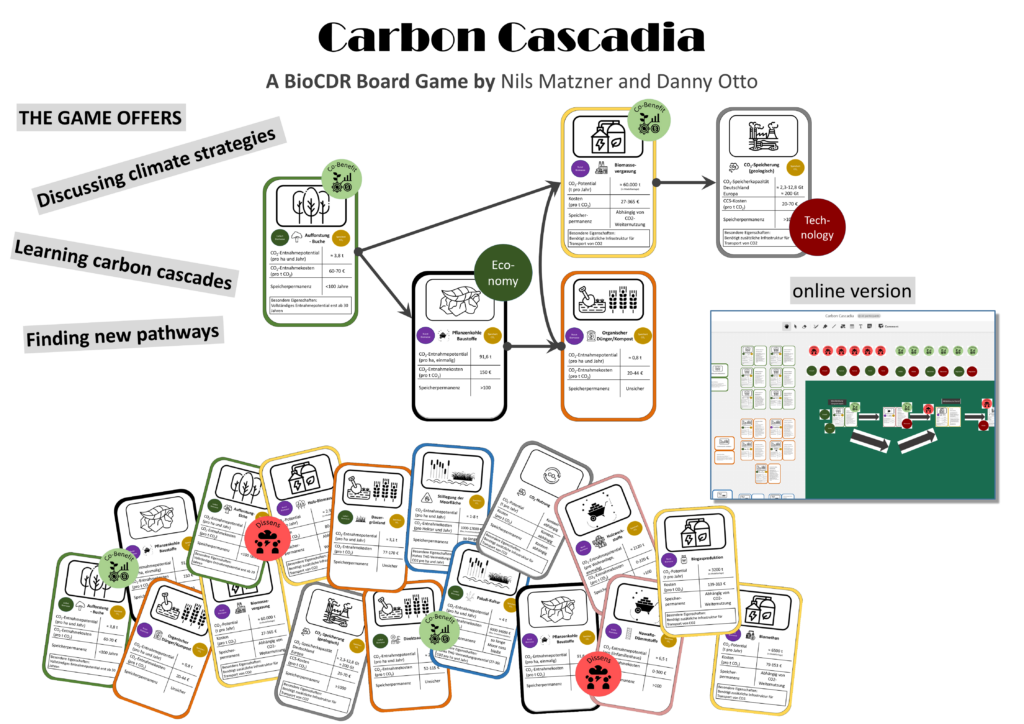Carbon Cascadia
/// The CO₂ Removal Game ///
Welcome to Carbon Cascadia, where you’ll embark on a journey through various methods of carbon dioxide removal (CDR). Explore the intricate mechanisms of CO₂ removal, weigh trade-offs and synergies, and experiment with organizing methods and biomass flows in cascades.
Stay tuned for more updates coming soon! We’re currently developing a simulation game for the computer. Get a sneak peek of what’s to come below and contact Nils and Danny for more information.
Background
“Carbon Cascadia” was developed within the BioNET project in response to the frequent discussions on biomass cascading during the workshops. The aim was to explore ways to use biomass and biogenic CO₂ through multiple stages and ensure long-term carbon storage with the goal of creating the most efficient, durable, cost-effective, and sustainable cascades, ideally generating additional co-benefits such as energy production or biodiversity conservation. Further information can be found in the discussion paper (German language).
Rules
The scenario
Climate change is already underway and emissions are still rising. Many international climate activists see an urgent need for CO2 extraction procedures to be carried out in order to avert the worst.
Farmers, foresters, thermal power plant operators, biochar start-ups, CO2 storage operators and many others are working together to establish the most effective, cost-effective, long-term and sustainable processes possible to remove CO2 from the air using plants and to bind it in the long term . Only if everyone works together can such biomass-based CDR measures also function as cascades, i.e. a series of extraction processes. The players cooperatively search for the best cascades
Goal of the game
The purpose of the game is to learn more about cascades of biomass-based CDR measures (BioCDR). The aim of the game is to create the most efficient, long-term, cost-effective and sustainable cascades possible, which may also have positive side effects, so-called co-benefits, such as energy production or the preservation of biodiversity.
Game preparation
Playing cards, arrows to connect the cards into cascades, markers and game board (or a suitable surface) will be provided for the workshop and can be used beforehand to develop initial ideas for cascades. In the online version of the game during the workshop, the materials are available digitally.
Game Phase 1 – Develop cascades
- Small groupsfromPlayers create one or more cascades of cards and arrows.
- A cascadebegins with a starting card that provides biomass. Start cards exist for silvicultural measures, agriculture and soils, and moor. They only serve to mark the beginning of the cascade.
- A corresponding card is placed on the start card. As the cascade progresses, several cards can be placed together that use biomass or CO2. To do this, the investment options must be taken into account, which are indicated by the circles next to the card name: provides biomass -> uses biomass -> stores CO2
- The number of cards placed is not limited by the rules of the game. Nevertheless, the cascades should remain technically and socially plausible.
- Players can add additional markers as the cascade progresses:
o Opportunities and challenges: green and red markers can be created
for opportunities and challenges in the areas of environment,
technology, social, politics, economics and regulation.
o Co-benefits: Positive side effects occur with a card or connection.
o Dissent: If the players cannot agree on a card or connection, marked.
- The first phase ends after 30 minutes.
Game Phase 2 – Evaluate cascades
To discuss the cascades, all players from the small groups come together in plenary.
The cascades are explained in turn. Questions of understanding are clarified.
The cascades are discussed according to the criteria:
o Amount of storage
o Storage permanence
o Amount of costs
o Number of co-benefits
o environmental sustainability
o Regionality of the Cascade
Gallery
